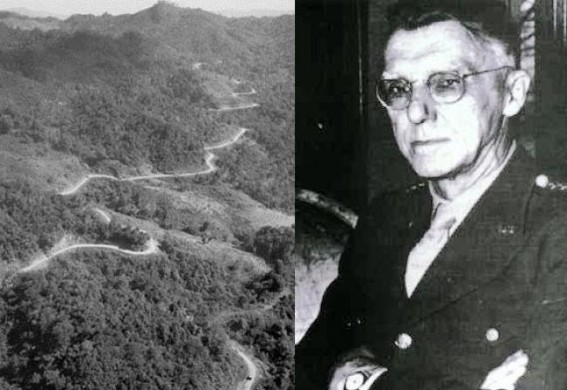Shilajit Kar Bhowmik

PHOTO : Left Pic : Aerial view of Ledo Road Right Pic: General Joseph Warren Stilwell
70 years have passed since the end of the Second World War in 1945 with the cataclysmic dropping of atom bombs in Hiroshima (August 6) and Nagasaki (August 9). Needless to say, the entire disaster took off with Nazi Germany’s invasion of Poland on 1st September, 1939. Nobody is oblivious to the consequences of perhaps the most devastating and catastrophic war in world history. The names of Adolf Hitler, Benito Mussolini, Sir Winston Churchill, Franklin D Roosevelt are household names in the context of the history of this war. Our country, at the key point, was in the brink of emancipation from British rule. The names of Mahatma Gandhi, Pandit Jawaharlal Nehru and Netaji Subhash Chandra Bose were the talk of the town.
However, North-East India’s humble connection albeit indirect at this point, almost faded into oblivion. This bears testimony to the fact that the Ledo Road in Assam, also called the Stilwell Road is discussed in mainstream circles, but not up to the mark. It is the concern only of the North-Easterners and that too Assam.
Ledo is a small town located at the Tinsukia district of Assam. The other name of Ledo Road, which is ‘Stilwell Road’, originates from the name of General Joseph Warren Stilwell. He was nicknamed by the world as ‘Vinegar Joe’ and his troops as ‘Uncle Joe’. Nevertheless, he was Chief of Staff to the allied forces in the China-India-Burma theatre under Marshall Chiang Kai-Shek. Chiang Kai-Shek was the Chief of Staff to Dr. Sun Yat-Sen, who was the founder of the Kuomintang or Nationalist Party of China in 1891. Dr. Yat-Sen later became the first President of China.
Coming back to the point, the Burma Road, which spanned 1,154 km from Kunming, Yunnan in Southwest China to Lashio, Burma was the only lifeline for China’s international supplies during its war of resistance against Japanese Aggression (1937 – 45). However, the Japanese overran Burma and severed the road, which forced the Allied forces to make a temporary and dangerous aerial route over the Himalayas, called the Hump route.
Simultaneously, the allies also gave a thought on constructing a permanent route which would be less inconvenient for sending supplies to China. On the other hand, the topography of the Indo-Burma border was a difficult terrain with thick, inaccessible and Malaria infested forests.
Hence, General Stilwell’s Operations Officer Lieutenant Colonel Frank D Merrill recommended a road on Ledo, Assam which would be connected with the severed Burma Road.
It all began with construction of warehouses, hospitals, barracks, and base roads at Ledo, Assam in December, 1942. Fighting with the Japanese forces persisted simultaneously. Finally, on December 16, 1942 building of the all-weather, double-track Ledo Road was set in motion.
With the course of time, Colonel Lewis. A Pick, an expert US army engineer was assigned the responsibility of the road’s construction.
Two years later, in late 1944, the Ledo Road was connected to the Burma Road. On January 12, 1945, a convoy of 113 vehicles began its journey from Ledo and reached Kunming, China on February 4, 1945 to celebrate and relish the achievement.
On 20 May, 1945, newly promoted Major General Lewis. A Pick proclaimed completion of the Ledo Road and describing it as ‘the toughest job ever given to US Army Engineers in Wartime.’
To bestow honour upon General Joseph Stilwell, the then Chinese Government renamed it what is now known as the ‘Stilwell Road’.
61 km of the road lies in India, 1,033 km in Myanmar (Burma) and 632 km lies in China. In India, 30 km of the road lies in Assam, while 31 km lies in Arunachal Pradesh.
Currently, demands of reopening the Stilwell Road are rife in the North-East as it envisages prosperity of the region under the framework of the Bangladesh-China-India-Myanmar (BCIM) economic corridor. However, the path is not rosy as a section of people envisions another Sino-Indian war once if the road is reopened.
But these theories should be debunked as because India’s defence strategies has bolstered in the past few years. To be precise, India has Agni V in its arsenal which is capable of hitting Beijing and Shanghai. Therefore, can China contemplate a war with India in such a situation?
Like it or lump it, the road named ‘Stilwell’ is a humble token of North-East India’s connection with WWII, which as a war have been immortalised in the annals of world history.
- Why Modi’s BJP swept key India regional elections
- TIWN’s landmark legal victory against BJP Govt’s Illegal attacks to shutdown fearless Media
- India to be world's third-largest economy by 2030 -S&P Global Ratings
- Tripura's Dark Era : Mafia style Brutal attacks on Journalists, fight for your Citizen rights !
- How to access tripurainfoway.com via HOLA from India



